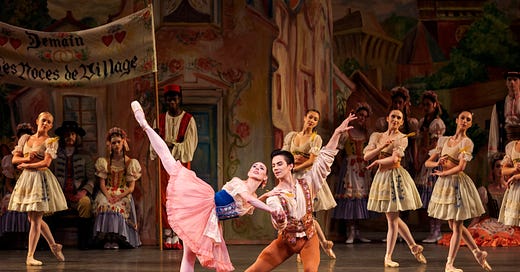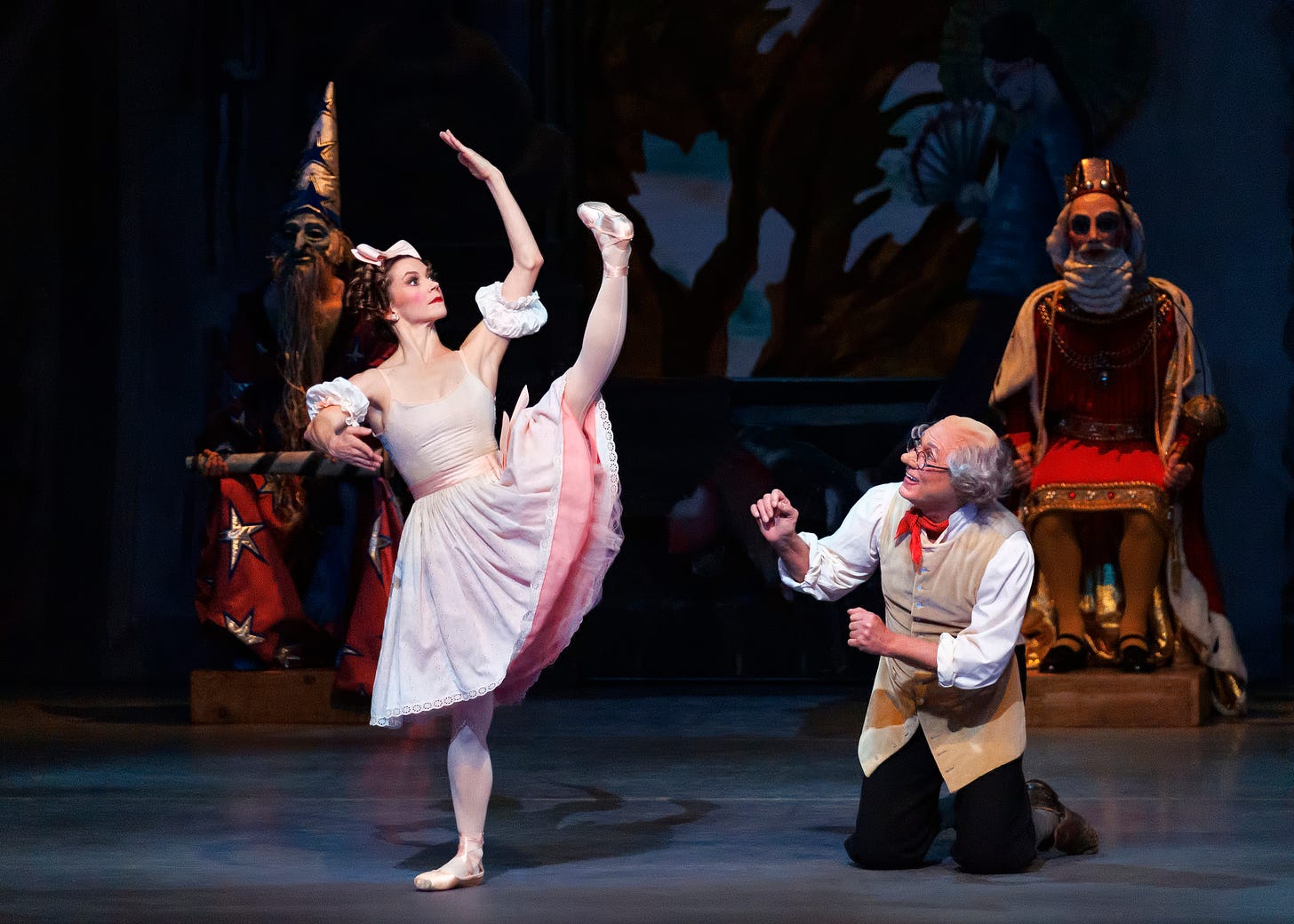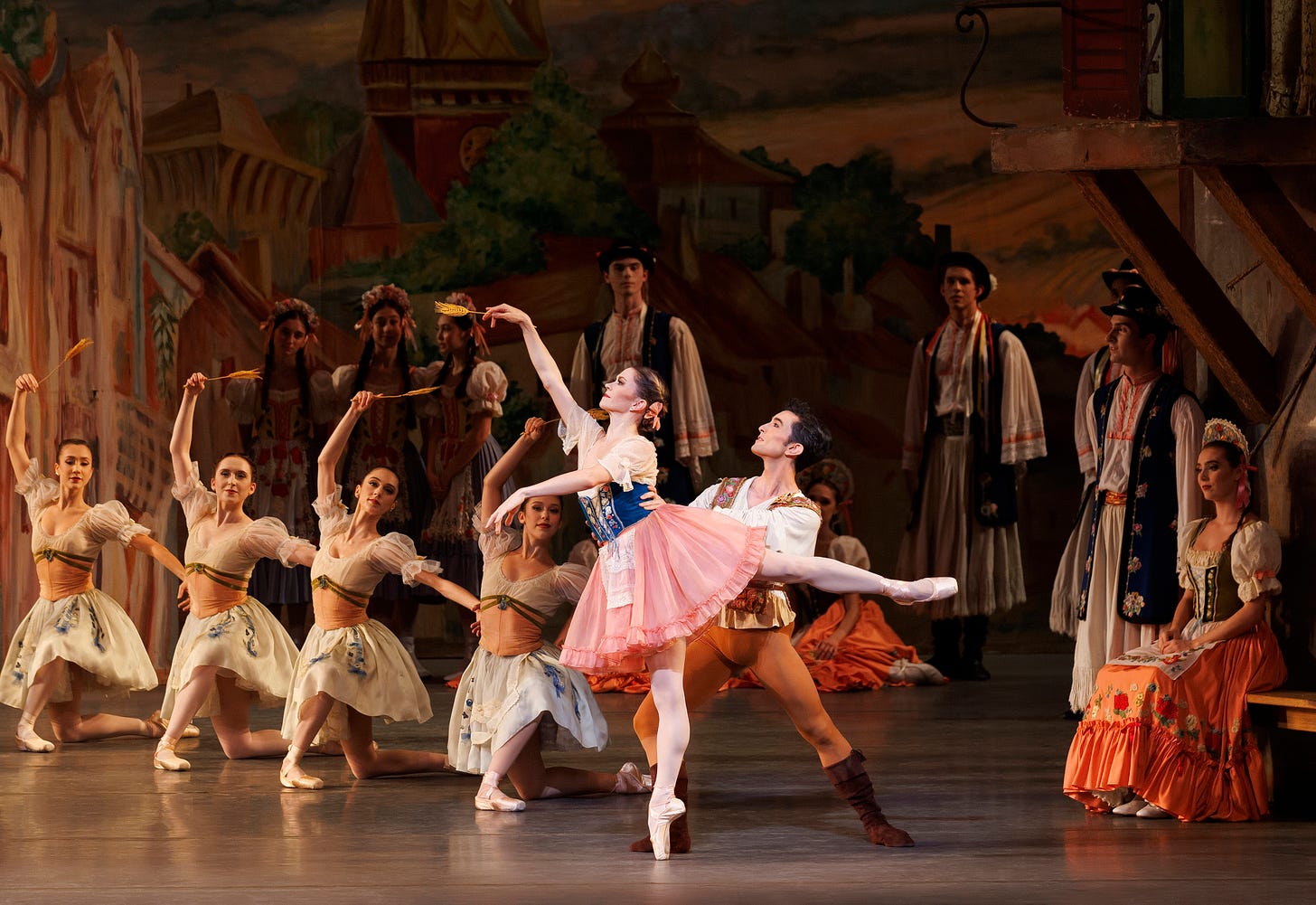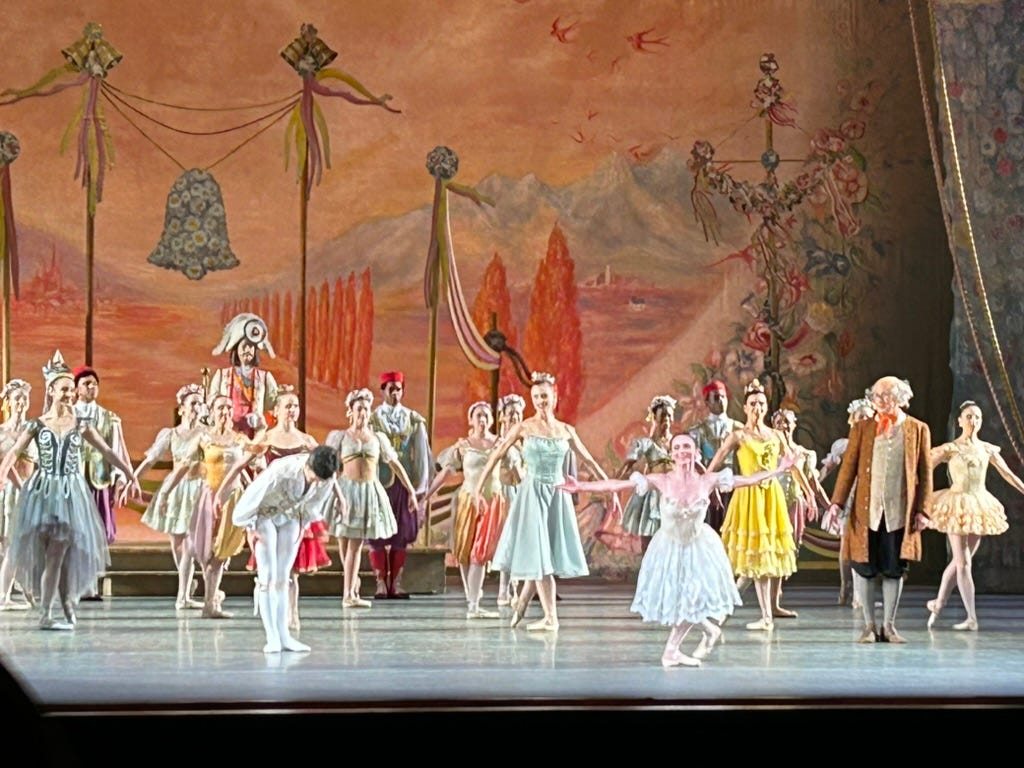Tiler Peck and Roman Mejia in Act I of Coppélia. Photo by Erin Baiano.
Balanchine once described Coppélia as “ballet’s great comedy,” comparing it to Giselle, which he considered ballet’s great tragic work. In many ways, the worlds and heroines of Coppélia and Giselle are quite similar: they are both Romantic ballets set in bucolic villages, though Coppélia’s setting is decidedly more sunny than Giselle’s, its inhabitants a tad more urbane. The heroines are young, lively, and in love with faithless young men who are nevertheless utterly charmed by them. Both include a scene in which an object drawn from nature—a flower in Giselle, a stalk of wheat in Coppélia—is used to predict whether or not love will prosper. In both cases, nature says no, but in Coppélia, love prospers anyway. And there is the element of magic, in Giselle’s case the dark magic of the Wilis, and in Coppélia, the pretend, but nevertheless spooky, magic represented by the automatons in Dr. Coppélius’s workshop.
Two parallel stories, with two very different outcomes. Balanchine’s 1974 staging of Coppélia, made in collaboration with Alexandra Danilova, renowned for her interpretation of the central character of Swanilda, returned last week to New York City Ballet for the first time since 2018. It carries within it other resonances: of Balanchine’s Nutcracker and of the ballet Mozartiana, which he would create seven years later, and even of the great Petipa ballet Sleeping Beauty (particularly in the final pas de deux). It is a delight on many levels, beginning with the glorious score by Léo Delibes, by turns glisteningly bucolic, playful, and dancey. (True, it was somewhat loudly and insensitively interpreted by the company’s music director, Andrew Litton.) The heart melts to the viola melody whose honeyed sound accompanies the ballet’s culminating pas de deux. The sunniness of the story; the charm and playfulness of its central character; the direct, straightforward mime; the sophistication of the “wheat dance,” a theme and variations for eight women; the bravura choreography for the dimwitted but nevertheless appealing Frantz; the fun of dances that imitate the movement of automatons. All of these ingredients add to the ballet’s harmonious and buoyant effect.
Megan Fairchild and Robert La Fosse in Act II of Coppélia. Photo by Erin Baiano.
City Ballet is currently fielding three casts of Coppélia, of which I caught two: Megan Fairchild with Anthony Huxley (and Robert La Fosse as Coppélius), and Tiler Peck and Roman Mejía (and Adam Hendrickson as the dollmaker). Both Swanildas were delightful, each in her own way. Fairchild was playful, crisp, natural, relaxed, funny, and wonderfully unmannered in both her dancing and her way of expressing herself through mime. Most interestingly, her character’s high spirits carried through in the pure-dance, ballerina passages—even at her most classical, Fairchild’s Swanilda was still the same fun, straightforward young woman. Peck’s performance was more artful in every way, musically sophisticated (even in the mime passages), thought through, and danced with ballerina authority. Technically, she was more dazzling: more expansive, more space-filling. But she lacked Fairchild’s spontaneity and spunk—a quality of pure, carefree enjoyment in the moment. It was half a dozen of one versus six of the other.
Where the two performances differed most was in their respective male leads. Huxley, a quiet, interior dancer, produced a rather princely Frantz, lacking the charm and extroversion we usually associate with the role. He was also having an off night. The usually impeccable technician could not quite find the rhythm or placement in his solos, especially the turning jumps, and his partnering was, as it often is, a little tentative. Fairchild, now in her 24th year with the company, ably overlooked the partnering glitches and was able to bring Huxley out of his shell just enough, but their partnership could only rise so far. In contrast, Roman Mejía, with his combination of bravura and charm, seems to have been born to dance the role of Frantz. He soared through the jumps, making the stage look almost too small for him; his beats were clean, the turns were fast and clean, the air turns landed just right, and, best of all he seemed to relish the partnering, adding flourish and a smiling panache to Peck’s movements. The two have an undeniable star power.
Though he does no dancing, Coppélius, like Drosselmeier in The Nutcracker, is central to this ballet, and here, too, the differences in interpretation were striking. Adam Hendrickson, who retired from the company in 2012, gave a perfectly respectable rendition, if a bit by the book. But Robert La Fosse, a star of an earlier generation, went much further, giving the character an inner life and touching romanticism. (His Drosselmeier is also memorable.) When his Coppélius thought he had magically brought his doll to life, giving her the gift of breath, he simply melted to the ground, as if totally overcome with love and wonder. It seemed he might die of happiness. Suddenly, this creepy-comic mad scientist became a real person, as deserving of love as any of us. (There is a theory that the doll Coppélia might be Coppélius’s way of bringing his dead wife back to life. In this performance, I believed it.)
Megan Fairchild and Anthony Huxley in Coppélia. Photo by Erin Baiano.
In this act, again, Fairchild, showed off her comedic timing, blinking and moving her shoulders perfectly to the music, performing the Spanish and Scottish dances in the style of a spirited young girl, having a lark. Peck, meanwhile, emphasized the transition from doll to human, and human to dancer, visibly warming and expanding as the act went on.
Not everything is perfect at the ballet, however. For one, Balanchine seems to have had little interest in the character dances of the first act (a mazurka and a czardas). They’re lively, yes, but have almost no folk feeling, nor any of the weightedness and twist in the upper body, shoulders and head that could turn these dances into a welcome counterbalance to the lightness and sparkle of the rest. The choreography here makes the dancers look even younger than they are, almost like students. And in the third act, where the original Coppélia assigned allegorical meanings to the series of solos that lead up to the climactic pas de deux, Balanchine created instead beautifully-crafted but un-specific dances for five female soloists, a quartet of “jesterettes,” and a battalion of spear-wielding warriors reminiscent of the Amazonian Hippolyta in his Midsummer Night’s Dream. None of these passages carries much weight, another lost opportunity, though the choreography is polished and sometimes imaginative.
“Prayer,” with its Sugarplum touches—sideways walks on pointe, turns with whirling arms—is warm and expansive, and the way the dancer relates to the ensemble of young girls from the school, à la Nutcracker and Mozartiana, is especially lovely. (Miriam Miller used her soft port de bras and pliant upper body to great effect here.) The jesterettes, their costumes stitched with shimmering bells, are like an expansion, on pointe, of the Candy Cane dance in The Nutcracker. Sara Adams was quietly absorbed and beautifully placed in the Waltz of the Golden Hours; Alston Macgill was light, buoyant, and sharp as the “Spinner.”
Roman Mejia and Tiler Peck in Coppélia. Photo by Erin Baiano.
About those little girls: twenty-four of them are used as the corps de ballet in this final act, dancing at times on their own, or framing and complementing the female soloists. In their precision and assuredness they are deeply impressive, able to fend for themselves without doubts or mistakes. A big bravo to their alma mater, the School of American Ballet, currently celebrating its ninetieth year. And they add to the warmth and approachability of Coppélia, a ballet that is about love, but also about joy and its close and even more appealing incarnation: happiness.
Anthony Huxley, Megan Fairchild, and the rest of the cast after Coppélia.









Lovely review Lynn. My biggest disappointment for my 16th birthday was a promise to see Danalova in Swan Lake.
Great review! Having never seen this version until this season I had the same feelings regarding the first act character dances and thought the corps itself was too “young” or undereducated in the style but your insights on the choreography, weightedness and use of head gave me more to ponder. Swanhilda is Megan’s role, she truly shone. Thank you for another intelligent review.